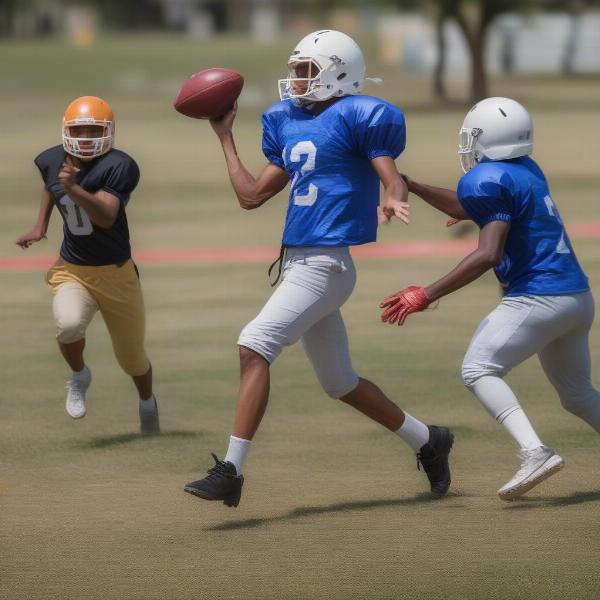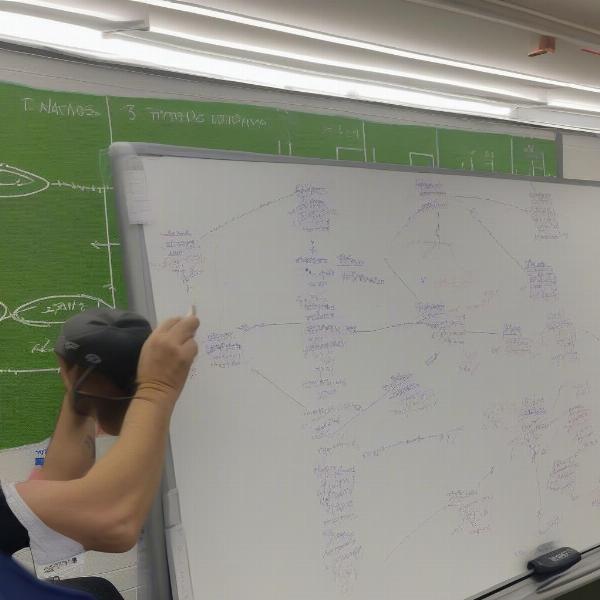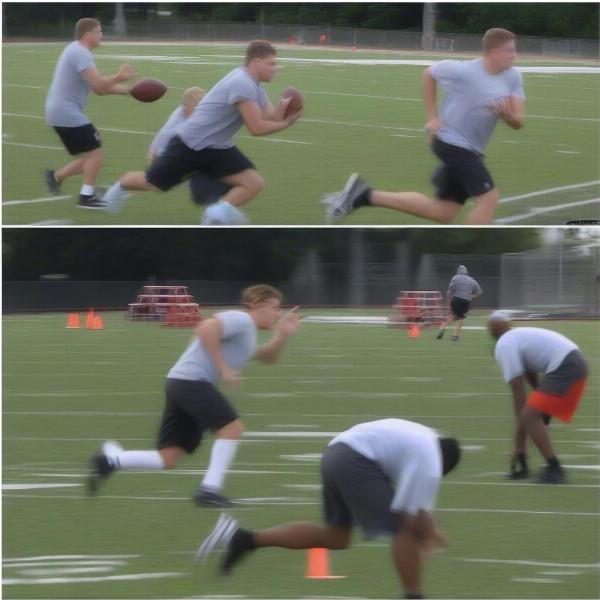7 on 7 football is a non-contact, passing-oriented version of American football played during the offseason. It focuses on developing passing skills, route running, and defensive coverage strategies. Unlike traditional 11-player football, 7 on 7 eliminates linemen and tackling, allowing quarterbacks, receivers, and defensive backs to hone their skills in a fast-paced, dynamic environment. It’s become incredibly popular for skill position development and provides an exciting, competitive outlet for players looking to improve outside of the regular season.
Similar to how long are 7th grade football games, the duration of 7 on 7 games can vary. Understanding the structure and purpose of 7 on 7 football is crucial for players and coaches looking to maximize their offseason training. This article dives into the specifics of what a 7 on 7 football game entails, covering everything from its core components to its strategic nuances.
Understanding the Basics of 7 on 7 Football
What exactly happens in a 7 on 7 football game? Seven players from each team take the field: a quarterback, a center (who only snaps the ball), and five eligible receivers on offense; and linebackers, cornerbacks, and safeties on defense. The game emphasizes passing plays, with running plays being non-existent. The quarterback has a limited time to throw the ball, typically four seconds, forcing quick decision-making and precise execution.
7 on 7 football is played on a field approximately 40 yards long, emphasizing the importance of short, quick passes and effective route running. The focus is on skill development, not physical dominance. This allows smaller, quicker players to shine and develop their talents without the pressure of heavy contact.
 7 on 7 Football Gameplay
7 on 7 Football Gameplay
Why is 7 on 7 Football So Popular?
7 on 7 football provides valuable opportunities for quarterbacks to refine their passing skills and build chemistry with their receivers. Receivers can perfect their routes and improve their timing, while defensive backs can enhance their coverage techniques and reaction times. This specialized training can translate to significant improvements during the regular season.
Coaches use 7 on 7 as a valuable tool to evaluate player performance, identify strengths and weaknesses, and experiment with different offensive and defensive schemes. It offers a controlled environment where players can develop their understanding of the game and improve their overall football IQ.
For those wondering how to watch the cheifs game, 7 on 7 tournaments often offer a chance to see future stars in action. Many high schools and youth organizations host 7 on 7 leagues and tournaments, providing a competitive platform for players to showcase their skills.
 7 on 7 Football Strategy
7 on 7 Football Strategy
The Strategic Landscape of 7 on 7 Football
7 on 7 football isn’t just about throwing and catching; it’s a game of strategy and execution. Offensive coordinators design intricate passing plays, utilizing various formations and route combinations to exploit defensive weaknesses. Defensive coordinators counter with complex coverage schemes, employing zone and man-to-man defenses to disrupt the passing attack.
“In 7 on 7, the mental game is just as important as the physical skills,” says Coach Michael Johnson, a renowned high school football coach with over 20 years of experience. “Players need to understand the nuances of the game, anticipate their opponent’s moves, and execute their assignments with precision.”
While the absence of linemen simplifies the game in some ways, it also presents unique challenges. Quarterbacks have less time to throw the ball, and receivers must be able to create separation from defenders without the benefit of blockers. Defensive backs need to be quick and agile, able to react to quick passes and maintain tight coverage.
Key Differences Between 7 on 7 and Traditional Football
The most obvious difference between 7 on 7 and traditional football is the absence of linemen and tackling. This changes the dynamic of the game significantly, shifting the focus from power and physicality to speed and skill. Another key difference is the scoring system. While touchdowns and extra points are still the primary ways to score, some 7 on 7 leagues also award points for first downs or completed passes.
Some argue that 7 on 7 doesn’t fully represent the complexity of traditional football. While this is true, the specialized training provided by 7 on 7 can be invaluable for skill position players. “7 on 7 is a fantastic tool for developing specific skills,” adds Coach Johnson. “It allows players to focus on the finer points of their positions and improve their overall understanding of the game.”
If you’re wondering has a football game ever ended 2 0, you’ll find the scoring in traditional football vastly different from 7 on 7, which typically sees higher scores due to its focus on passing. Knowing these differences provides context for the role of 7 on 7 in player development.
 7 on 7 Football Training Drills
7 on 7 Football Training Drills
The Future of 7 on 7 Football
7 on 7 football continues to gain popularity, with more and more leagues and tournaments popping up across the country. It has become an integral part of the offseason training regimen for many high school and college football programs. As the game evolves, we can expect to see even more sophisticated strategies and innovative training techniques emerge.
7 on 7 provides a platform for players to improve their skills, coaches to evaluate talent, and fans to enjoy exciting, fast-paced football action. Its impact on the development of young athletes is undeniable, and its future looks bright.
Conclusion
7 on 7 football is a valuable tool for developing passing and receiving skills in a fast-paced, competitive environment. It allows players to refine their techniques, build chemistry, and improve their understanding of the game. While it differs from traditional football, its specialized training translates to significant benefits during the regular season. As you consider your football training options, understanding “What Is A 7 On 7 Football Game” is essential for maximizing your potential. Consider joining a local league or tournament to experience the benefits of 7 on 7 football firsthand.
FAQ
-
What positions are involved in 7 on 7 football? Quarterback, center (for snapping), receivers, linebackers, cornerbacks, and safeties.
-
Is 7 on 7 football full contact? No, it is a non-contact version of football focusing on passing.
-
How long is a 7 on 7 football field? Approximately 40 yards.
-
Why is 7 on 7 football beneficial? It helps develop passing skills, route running, and defensive coverage strategies.
-
How does scoring work in 7 on 7 football? Primarily through touchdowns and extra points, but some leagues also award points for first downs or completed passes.
-
Where can I find 7 on 7 football leagues near me? Check with local high schools, youth organizations, and sports facilities. For those looking for professional game streams, check out resources like where can i watch the panthers game or where to stream minnesota vikings game.
-
Is 7 on 7 football a good way to prepare for the regular season? Absolutely, it provides valuable specialized training that can significantly improve performance.

